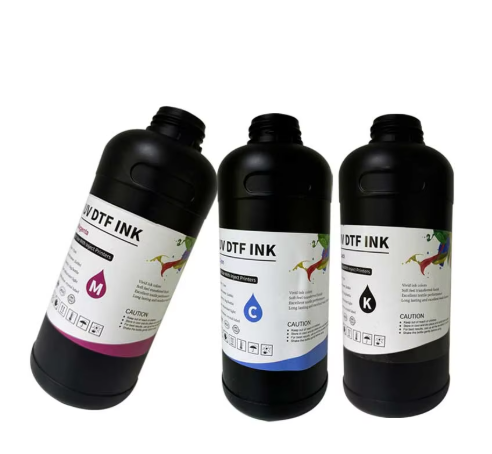Materiyel Esnekliği Uv dtf yazıcıları
Plastikler ve Akrilikler
UV DTF yazıcılar PVC, poliester ve policarbonat levhalar gibi plastiklerin yanı sıra tüm türde malzemeleri işleyebilir. Bunu mümkün kılan şey ise özel UV ile sertleşen mürekkeplerin bu yüzeylere çok iyi yapışmasıdır. UV sertleştirme konusunda bahsedilen temel süreç, mürekkebin plastik yüzeylere malzeme üzerinde gerçekleşen oldukça etkileyici kimyasal olaylar sayesinde sağlam bir şekilde bağlanmasıdır. Bu bağlanma süreci, geleneksel yöntemlerin ötesinde çok daha dayanıklı baskılar elde edilmesini sağlar. Güneş, yağmur ve doğanın diğer etkilerine maruz kalacak dış mekân ürünlerinde bu baskılar solmadan ya da tamamen dökülmeden çok daha uzun süre kalıcılık gösterir. Bu yüzden son zamanlarda birçok tabela üreticisi ve dış mekân reklamcılığı yapan şirket DTF teknolojisine geçiş yapmıştır.
Akrilik yüzeyler, saydamlıkları ve üzerine baskı yapmaya uygun olmaları sebebiyle UV DTF yazıcılarla oldukça iyi sonuç verir. Bu yazıcıların teknolojisi, zamanla dayanıklı kalan ve hatta çeşitli hava koşullarına maruz kalındığında bile solmayan veya silinmeyen canlı renkler sunar. Dahası, UV DTF yazıcılar çok net detaylar üretebilir; bu nedenle plastik panellerden akrilik vitrinlere kadar çeşitli malzemelere karmaşık tasarımlar basılmasında oldukça yaygındır. İşletmeler için bu özellikle yararlıdır çünkü kalite ve dayanıklılığın bir arada önem taşıdığı birçok sektörde kullanım imkanı sunar.
Cam ve Seramik Yüzeyler
UV DTF baskı, cam ve seramik yüzeylerde de oldukça iyi sonuç verir. Bu teknoloji, insanların hem estetik hem de işlevsel ürünler oluşturmak istedikleri durumlarda çeşitli malzemeler üzerine detaylı desenler basmalarına olanak tanır. Bu yüzden kahve fincanları ya da banyo karoları gibi ev ya da ofiste uzun süre kullanılacak ürünler üretilirken bu yazıcılar tercih edilmektedir. Bunu mümkün kılan şey, sistemin beraberinde sunduğu özel mürekkeplerdir. Bu mürekkepler, baskı yapıldıktan hemen sonra cam ve seramik yüzeylere neredeyse anında yapışmaktadır. Çoğu kişi, baskıların ev ya da ofis ortamında aylarca kullanıldıktan sonra bile parlaklığını koruduğunu ve kolay kolay çizilmediğini fark etmektedir.
Araştırmalar, UV DTF baskınının eski baskı tekniklerine göre cam ve seramik yüzeylerde çok daha uzun süre dayandığını göstermektedir. Bunun nedeni? O özel UV ile sertleştirilen mürekkepler bu malzemelere daha iyi yapışmaktadır, bu yüzden zamanla dökülmez ya da rengini kaybetmezler. Ev eşyalarını kişiselleştirmek isteyen kişiler için bu oldukça önemlidir. Herkesin sevdiği özel tasarımli kahve fincanlarını ya da yıllarca kullanılsa bile görkemli görünmeye devam eden karmaşık desenli banyo karolarını düşünün. Cam eşya ve seramiklerle çalışmak için bir UV DTF yazıcıya yatırım yapan bir kişi, evdeki farklı koşullara ve düzenli kullanıma rağmen görünümlerini koruyan, başlangıçta harika görünen ürünler elde eder.
UV DTF Baskısı için Metal ve Tahta Alt Malzeme
Paslanmaz Çelik ve Alüminyum Uygulamaları
UV DTF yazıcılar, paslanmaz çelik ve alüminyum gibi metaller üzerine baskı yapmada oldukça iyi sonuç vermektedir ve bu da onları uzun ömürlü ürünler arayan işletmeler için oldukça önemli hale getirmektedir. Baskılar gerçekten çizilmelere karşı dayanıklı olup kolay kolay solmamaktadır, bu yüzden ürünlere zorlu koşullara maruz kalsa bile çok daha uzun ömür kazandırmaktadır. Son bazı piyasa araştırmalarına göre, özellikle UV baskının çalışma biçimindeki gelişmeler sayesinde, geçen yıl bu tür metal baskı ürünlerine olan talepte yaklaşık %20 artış görülmüştür. İnsanlar özellikle metallerin hem estetik açıdan güzel görünmesini hem de yıpranmalara karşı dayanıklı olmasını istemektedir ve bu durum özellikle inşaat ekipmanları ve dış mekan mobilyaları üreticileri tarafından dikkat çekici biçimde fark edilmiştir.
Doğal ve Mühendislikli Ahşap Performansı
Ahşap, doğadan direkt elde edilmiş ya da işlenmiş haliyle UV DTF baskı için oldukça iyi bir temel malzeme olarak çalışır. Doğal ahşap baskılı parçalara özel bir hava katar; iki parça birbirinin aynısı olmaz, üstelik dokunulduğunda sıcak bir his uyandırır. İşlenmiş ahşap ise baskı makinelerine en çok ihtiyaç duydukları şeyi sunar: birden fazla ürün arasında tutarlılık, bu da büyük seri baskılar için oldukça önemlidir. UV mürekkepleri ahşap yüzeylere oldukça iyi tutunur, bu yüzden renkler canlı kalır ve ince detaylar bile elle tutulduktan sonra bile netliğini korur. Bazı testler, belirli tür işlenmiş ahşaplara yapılan baskıların, herhangi bir solma ya da hasar belirtisi göstermeden yaklaşık 10 yıl dayandığını göstermiştir. Bu tür dayanıklılık, birçok sanatçının ve tasarımcının kalıcı duvar sanatı, özel mobilya parçaları ya da evlerde ve ticari alanlarda zaman testinden dayanacak şekilde üretilmiş dekoratif ürünler yapımında UV DTF baskıyı tercih etmesinin nedenidir.
Özel UV DTF Yazıcı Malzemeleri Benzersiz Projeler İçin
Deri ve Kumaş Baskı Yetenekleri
UV DTF teknolojisi, deri ve kumaşlarla neler yapabileceğimizi değiştiriyor; özel çanta ve giysilere yüksek kaliteli baskılar yapabilmemizi sağlıyor. Bu teknolojiyi özel kılan şey, farklı malzeme yüzeyleriyle uyumlu çalışması ve onlara karşı koymaması. Mürekkep, birkaç yıkamadan veya kullanımdan sonra dökülmeden zorlu doku tiplerinde bile iyi yapışır. Büyük avantajlardan biri, tasarımcıların düzgün deri ceketlerden pürüzlü tuval çantalara kadar her şeye harika görünen detaylı desenler ve canlı renkler oluşturmasına olanak tanıyan UV mürekkepleridir. Ülke genelindeki baskı atölyeleri bu yöntemi benimsemeye başladı çünkü müşteriler günümüzde ürünlerinin dikkat çekmesini istiyor. İnsanlar yerel olarak gerçekten eşsiz ürünlerin üretilebileceğini fark ettikçe tamamen yeni pazarların açıldığını görüyoruz; bunlar seri üretilen alternatiflerin yerine geçebilecek ürünlerdir.
Özelleştirilmiş Telefon Kuşakları ve Teknoloji Eklentileri
Bugünlerde insanlar telefon kılıfları ve diğer teknolojik aksesuarlara kendi yorumlarını katmaktan hoşlanıyor ve UV DTF baskı, gerçekten detaylı özelleştirilmiş tasarımlar elde etmenizi sağlıyor. Bu yöntemin harika olan tarafı, tüm türlerde plastik malzemeler üzerinde çalışmasıdır, bu yüzden işletmeler, bireysel tercihlere en ince detayına kadar uygun ürünler oluşturabiliyor. Pazar araştırmaları ayrıca ilginç bir şeyi gösteriyor: mobil aksesuarlar için özelleştirme sektörünün önümüzdeki beş yılda patlaması bekleniyor. Bunun nedeni ise insanlar sadece kendilerine ait, sanki onlar gibi görünen şeyleri istiyorlar. UV DTF teknolojisi de kişisel dokunuşları çeşitli malzemeler üzerinde gerçekleştirmek açısından sürekli gelişiyor. Müşterilerin isteklerine adapte olan şirketlerle birlikte, tekil ürünler için artan bu talep etrafında tamamen yeni pazarların şekillendiğini görüyoruz.
UV DTF Teknolojisi ile Karmaşık Şekilleri Yönetme
Silindirik Nesneler: Kuvvetli ve Bardaklar
UV DTF teknolojisi, şişeler ve fincanlar gibi yuvarlak nesneler üzerine baskı yapma biçimimizi değiştirdi. Özel yöntemler, mürekkebin tüm zorlu eğrileri kaplamasını ve hiçbir alanı boş bırakmamasını sağlıyor. Bu sistemin en güzel yanı, ince detayları koruyarak farklı boyutlarda çalışabilmesi. Bu özellik, şirket hediyelik eşyaları veya doğum günü hediye gibi özel şeyler istenen alanlarda mükemmel bir seçenek haline getiriyor. Günümüzde kişiselleştirilmiş içecek kaplarına olan talep arttığından, işletmelerin UV yazıcılar alarak bu alana yatırım yapmaları ciddi kazanç sağlayabilir. İnsanların seri üretime dayalı ürünlerden farklı şeyler istemesi nedeniyle, şu anda silindirik baskı teknolojisine yatırım yapan şirketlerin ileride ciddi büyüme potansiyeline sahip olduğu görülüyor.
3B Dokulu Yüzey Baskı Teknikleri
UV DTF teknolojisindeki yeni gelişmeler, tasarımcıların tüm çeşitlerde 3B dokulu yüzeyler üzerine baskı yapmasına olanak tanıyor ve yaratımlarına gerçek bir derinlik ve boyut kazandırıyor. Sanat malzemeleri dahil olmak üzere çeşitli sektörlerdeki işletmeler için evine dekore ve ambalaj sayesinde müşterilere gerçekten özel şeyler sunabilir bu çığır açan teknoloji sayesinde. Sektörel raporlara göre, 3D yüzey baskısının son yıllarda ne kadar büyük bir rol oynadığını gösteren günlük eşyalar için bu tür dokulu yüzeylerin kullanımını artıran şirket sayısında ciddi bir artış gözlemleniyor. Bu durumun en çok dikkat çeken yanı ise üreticilere kalabalık pazarlarda fark yaratmaları için yeni yollar sunarken, insanların dokunmak ve etkileşime girmek istediği ürünlere de olanak sağlamasıdır.
En İyi UV DTF Sonuçları İçin Malzeme DüşünCELER
Yüzey Hazırlama En İyi Uygulamalar
UV DTF teknolojisiyle çalışırken, iyi bir yapışma ve kaliteli baskılar elde etmek için yüzeyin doğru şekilde hazırlanması çok önemlidir. Tozların temizlenmesi, yüzeye gerekirse hafifçe zımpara yapılması veya astar uygulaması, UV mürekkebinin baskı yapılacak malzeme üzerinde daha iyi tutunmasını sağlar. UV mürekkeplerle iyi çalışan malzemelerin seçilmesi de büyük bir fark yaratır. Bazı plastikler özel bir işleme tabi tutulmadan UV mürekkebiyle düzgün şekilde tutmaz. Baskı atölyelerinde çalışan kişiler bu konuları çok iyi bilir. Yüzeyleri doğru şekilde hazırlamanın sadece kuralları takip etmek değil, baskıların daha uzun süre dayanmasını sağlamak anlamına geldiğini herkese anlatır dururlar. Doğru şekilde hazırlanmış bir yüzey sayesinde renkler solmadan, keskin ve canlı kalır; sadece birkaç hafta sonra solmaz.
Farklı Malzeme Türlerinde Dayanıklılık
UV DTF baskılar, neredeyse her türlü malzeme üzerine dayanıklılıkları sebebiyle öne çıkar ve hem tüketici ürünleri hem de fabrika ortamlarında kullanılan ürünlerde avantaj sağlar. Bu baskıların ne kadar dayanacağı, kullanılan mürekkep türüne, üzerine basılan yüzeye ve ürünün nerede kullanıldığına bağlı olarak değişir. Laboratuvar testleri, UV DTF baskıların güneşe maruz kalma, ıslanma ve diğer baskı tekniklerine göre daha fazla darbeye karşı renklerini koruyarak daha iyi performans gösterdiğini ortaya koymuştur. Özellikle dayanıklılık isteyen işlerde bu yöntemi tercih etmenin mantıklı olduğu anlaşılıyor. Ayrıca renkler, aylarca ya da yıllarca sergilenmeye devam ettikten sonra bile canlılığını korur ve zaman içinde iyi görünmesi gereken ürünler için büyük önem taşır.
Sıkça Sorulan Sorular
UV DTF yazıcıları hangi türdeki malzemelerde yazdırabilir?
UV DTF yazıcıları, plastikler, akryller, cam, seramik, metaller (gibi rusti çelik ve alüminyum), ahşap (hem doğal hem de mühendislikli), deri, dokuma malzemeler ve hatta silindirik nesneler gibi karmaşık şekiller dahil olmak üzere geniş bir yelpazede malzeme üzerinde yazdırabilir.
Neden UV DTF baskıları geleneksel baskılardan daha dayanıktır?
UV DTF baskıları, UV ışığına, nemlere ve aşmaya karşı harika bir direnci sağlayarak zeminle güçlü bir şekilde bağlanır çünkü iyileştirme sırasında UV sertleşebilir mürekkepler kullanılır. Ayrıca, uygun yüzey hazırlığı bu dayanıklılığı daha da artırır.
UV DTF teknolojisinin tipik uygulamaları nelerdir?
Tipik uygulamalar arasında tanıtım ürünleri, ev dekorasyonu, kişiselleştirilmiş hediye eşyaları, cep telefonu kılıfları, teknolojik aksesuarlar ve özelleştirilmiş içecek kapları yer alır. Bu teknoloji, aynı zamanda deri, kumaş ve karmaşık 3D yüzeyler üzerine baskı yapmak için de kullanılmaktadır.

